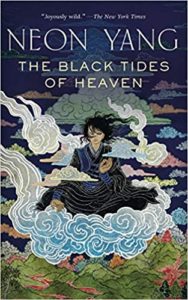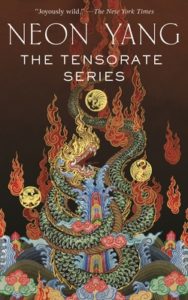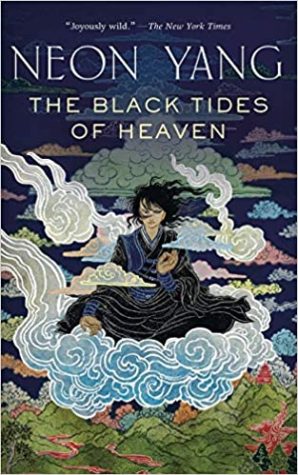
Summary [courtesy of Goodreads]: Mokoya and Akeha, the twin children of the Protector, were sold to the Grand Monastery as children. While Mokoya developed her strange prophetic gift, Akeha was always the one who could see the strings that moved adults to action. While his sister received visions of what would be, Akeha realized what could be. What’s more, he saw the sickness at the heart of his mother’s Protectorate. A rebellion is growing. The Machinists discover new levers to move the world every day, while the Tensors fight to put them down and preserve the power of the state. Unwilling to continue to play a pawn in his mother’s twisted schemes, Akeha leaves the Tensorate behind and falls in with the rebels. But every step Akeha takes towards the Machinists is a step away from his sister Mokoya. Can Akeha find peace without shattering the bond he shares with his twin sister?
In honor of Neon Yang’s complete Tensorate series being released in a gorgeous bind-up today, I thought it was high time I feature the amazing first novella in their series.

I’ve had a digital copy of this novella for ages, but I wasn’t sure if I’d enjoy it because I thought it was mainly a ‘political machinations’ fantasy. Turns out, though, it’s more a sibling love/queer love/rebellion of the oppressed kind of fantasy, which is very much more my jam. So of course I enjoyed this book, though I do wish it wasn’t as slight as, in some ways, it is. I can’t wait to read the other three books in the series and find out how some of these gaps are filled in!
First of all, the relationships and characterizations here were deep and well-drawn despite the story’s relatively short length. When I said the novel was slight, I was NOT referring to character-building. The relationship between twin tensors Mokoya and Akeha is crafted so carefully, from their extreme childhood bond to the complications that arise as they age, choose genders, and forge relationships with others outside of their dyad.
In this world where slackcraft (elemental magic) is wielded by tensors, children are born genderless. They select their gender (or, in many cases, just know which gender they are) as they age, usually by the time they hit 18 or so. Once a person identifies their gender, tensor doctors use slack to modify their bodies, smoothing bones, growing hair, changing muscles, etc. The process IS brief but recovery time is non-negligible. It’s a fascinating idea that plays against limited Westernized notions of immutable gender, though in this world (at least so far), male and female remain the only normative ‘genders’ people can get confirmed as. However, even in the brief glimpse of the world this novella affords, there are exceptions to these rules.
SPOILER TERRITORY
As a child, Akeha struggles with choosing a gender: they know that feminine pronouns don’t fit and couldn’t imagine themself as a woman, and they initially aren’t excited about the idea of confirmation at all. After Mokoya definitively asserts her womanhood, though (“I didn’t decide…I’ve always felt like one. A girl.”), Akeha secretly tries out male pronouns:
“Their heart quickened in their chest. The words rolled and clicked in their mind, sharp and electric. I want. I want. I want.”
“Not right, exactly, but there was something there.”
Having grown up around almost entirely women, with a few notable exceptions, Akeha is shocked at the possibilities being male would open up for him (and it’s at this point that the narration switches from “they” to “he” pronouns for the character). But the hesitation there is interesting, suggesting that Akeha might be more comfortable in a less binarily-defined society. His later relationship with rebel Yongcheow, a man who confirmed his gender without doctor intervention (“I just didn’t do it because it didn’t feel right for me.”), furthers this idea that there are those who quietly resist–or at least question–the embodied elements of gender that this society insists on.
So even in a world much queerer, in some ways, than the cultures that are dominant in our own world, there are paradigms (like confirmation) that free some people while limiting others. The subtle gender resistance in this world, where same-sex relationships are seemingly normalized (the twins’ mother, the Protector, has relationships mostly with women), is fascinating and complex, an interesting juxtaposition with the more straightforward rebellion of the Machinists vs. the Protectorate.
The main political struggles in the novella result from the authoritarian Protectorate regime and the way it, led by the all-powerful tensor Protector, squashes all uprisings from minority ethic groups, rival political factions, or those of differing philosophical persuasion. Ultimately, things come to a head because the Protectorate and the magical tensors who uphold it want to keep technological advancements within the realm of tensors, or magic-wielders, while rebelling (usually impoverished) Machinists, including some tensor allies, want to create non-magical analogues for everyday folks to be able to use. It’s an archetypal elites-vs-workers fight, and so it’s easy to create sympathy for the Machinists even in a brief amount of pages.
The political struggle adds stakes to this world and our relationship to the main characters, from the way insurrection threatens Akeha’s beautifully-rendered relationship with Yongcheow to the way weapons development accidentally kills Mokoya’s cherished daughter Eien (a precocious, self-determined child who knew she was a girl by the age of 3). The novella never shies away from the brutalizing effects of violence and weapons, particularly the massive bomb technology that only the most powerful tensors (basically just Akeha) can control. (One of Yang’s exquisitely worded passages reflects on the horrific power of the bomb and how, “it begged for taxonomy that bayed of what it could do.”)
Overall, despite the way this book moves quickly through time (from the twins infancy through their 35th year), skipping ahead whole decades, it was surprisingly immersive and easy to follow. Much of that is due to Yang’s amazing writing and the way it propels you along, by turns achingly poetic (“Akeha kissed him hard, their lips issuing a commandment of desire, playing a symphony of desperation.”) and inventively sharp (“A gangrenous smile spread across his face.”). In some ways, this is more a series of connected vignettes into these characters’ lives than a fully-fleshed-out plot, but it definitely works. And the glimpses it gives into this world have me bouncing at the chance to dive back in.



